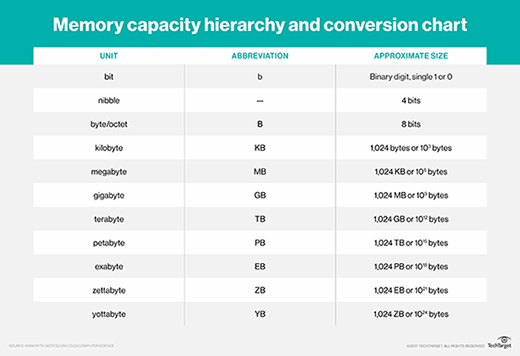yottabyte (YB)
What is a yottabyte (YB)?
A yottabyte (YB) is a measure of theoretical storage capacity and data volumes equal to 2 to the 80th power bytes, or approximately a million trillion megabytes (MB). This measure is used to denote the size of data.
The prefix yotta is based on the Greek letter iota. In decimal format, a yottabyte is written as 1,208,925,819,614,629,174,706,176.
Currently, there is nothing that can be measured on a yottabyte scale.
According to Paul McFedries' book Word Spy, it would take approximately 86 trillion years to download a 1 YB file, and the entire contents of the Library of Congress would consume just 10 terabytes (TB).
How big is a yottabyte?
A yottabyte is the largest unit approved as a standard size by the International System of Units (SI). The yottabyte is about 1 septillion bytes -- or, as an integer, 1,000,000,000,000,000,000,000,000 bytes. The storage volume is equivalent to a quadrillion gigabytes (GB) or a million trillion megabytes. By comparison, the average song file is around 10 MB to 30 MB.
A yottabyte is so much data that, according to backup vendor Backblaze Inc., a yottabyte of storage would take up a data center the size of the states of Delaware and Rhode Island.
Yottabytes vs. terabytes vs. petabytes
While yottabyte storage is not yet in use, big data and the demand for higher-capacity drives grows every year.
One byte is the equivalent of 8 bits of data. Growing in order, other data examples include the following:
- 1,024 bytes = 1 kilobyte (KB). For reference, 50 KB is about the size of a compressed document image.
- 1,024 kilobytes (KB) = 1 MB. The size of a high-resolution RAW file from a 24-megapixel camera is about 50 MB.
- 1,024 MB = 1 GB. An average movie in 1080p quality may take up 1.5 GB to 2 GB of space.
- 1,024 GB = 1 TB, which is about 1,613 650 MB CDs worth of data.
- 1,024 TB = 1 petabyte (PB). This is equivalent to about 1.5 million CD-ROMs worth of data.
- 1,024 PB = an exabyte (EB). This was roughly the amount of digital information created on the internet each day in 2012.
- 1,024 EB = a zettabyte (ZB), which is the equivalent of about 30 billion 4K movies.
- 1,024 ZB = 1 YB. According to Backblaze, a yottabyte of storage would require a million data centers.
Manufacturers and professionals use a slightly different conversion method to simplify the numbers. Conversions are in steps of 1,000. For example, 1,000 bytes represents 1 KB; 1,000 KB represents 1 MB; 1,000 MB represents 1 GB; 1,000 EB represents 1 ZB, and so on.

Hard drives scaling at a terabyte level are commonly available in the storage market. In 2015, DataDirect Networks, EMC Corp. (now Dell EMC), Fujitsu and HGST (Hitachi Global Storage Technologies, a Western Digital brand) released petabyte-scale storage devices ranging from 4.6 PB to 50 PB.
What’s bigger than a yottabyte?
Yotta is the biggest prefix recognized by the SI, mainly because there is currently no need for any bigger prefix. There are still other unofficial units that exist, however. For example, the brontobyte is one of the most well known.
A brontobyte is approximately 1,024 YB. Brontobyte is derived from the name Brontosaurus, one of the largest dinosaurs. Using simplified numbers, a brontobyte is equal to the number one followed by 27 zeros.
Is the yottabyte in use?
Yottabyte storage is not yet in use, and there is nothing yet currently big enough to measure in yottabytes. For example, in their blog post titled "How Much Data is Created Every Day?" job recruitment hub SeedScientific estimated the amount of global information created at the beginning of 2020 to be 44 ZB. By 2025, the projected amount of data generated each day globally will reach 463 EB.
In 2014, the U.S. Intelligence Community completed construction of the Utah Data Center, which was reportedly designed to handle yottabytes of data. However, experts estimated the $1.5 billion data center's capacity is between 3 EB and 12 EB. But according to the 2019 IEEE Spectrum article "Racing Toward Yottabyte Information," the world will reach data in the yottabytes within a decade.
The history and evolution of bits and bytes
- In 1951, the first tape drive was created for a commercial computer.
- In 1952, IBM announced its first magnetic tape unit, the IBM 726. It could store about 1.1 MB on one reel of tape.
- In 1963, DECtape is introduced for use in Digital Equipment Corp. computers. Its 3.75-inch tape with 8 bits could be expanded to 12 bits.
- In 1967, IBM began working on the IBM floppy disk drive. In the 1960s, IBM also introduced the 8-bit Extended Binary Coded Decimal Interchange Code (EBCDIC), which led to the adoption of 8-bit storage sizes.
- In 1978, MCA (now Pioneer) and Philips introduced the LaserDisc.
- In 1980, the first hard disk drive for microcomputers is announced: the 5.25-inch Seagate ST506. It held 5 MB of data.
- In 1981, Sony introduced the first 3.5-inch floppy drive. It held a formatted capacity of 161.2 KB.
- In 1983, the largest hard drives held about 10 MB of data.
- In 1984, Sony and Philips announced the compact disc read-only memory, or CD-ROM. It held 550 MB of prerecorded data. That same year, Fujio Masuoka -- then a Japanese engineer working for Toshiba, and now CTO of Unisantis Electronics -- developed flash memory, which could be powered off and still keep data, as well as be erased and reprogrammed multiple times.
- In 1994, SanDisk introduced the CompactFlash memory card, which was widely adopted into consumer devices.
- In 1999, IBM introduced the Microdrive. At 1 inch, it was the smallest hard drive in the world at the time and offered capacities of 170 MB and 340 MB.
- In 2000, USB flash drives are introduced. These portable storage devices, which had a capacity of 8 MB, were responsible for the demise of floppy and optical disks.
- In 2007, HGST announced the first 1 TB hard disk drive.
- In 2009, technical work began on non-volatile memory express, which today is used for solid-state storage, main memory, cache memory and backup memory.
- In 2015, HGST announced the first 10 TB hard drive.
- In 2020, the amount of estimated data in the world was 44 ZB.
- By 2025, the amount of data generated every day is expected to be about 463 EB.
Learn about scale-out NAS and how it is designed to support volumes of up to 8 YB of data.







